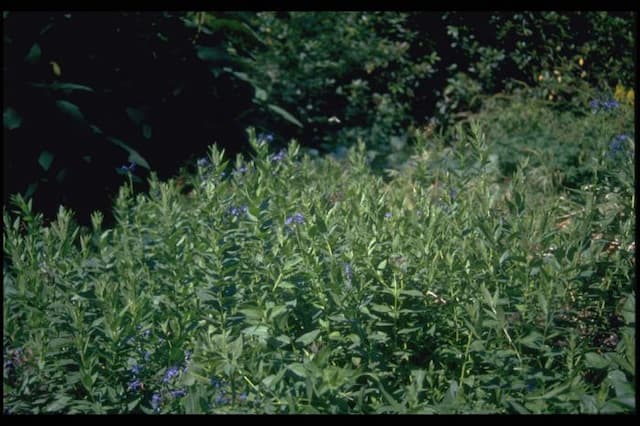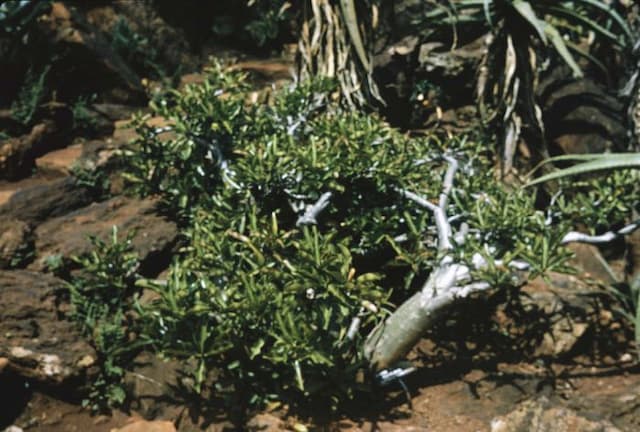Golden Trumpet Allamanda cathartica

ABOUT
Allamanda cathartica, commonly known as golden trumpet, is a vibrant tropical plant known for its trumpet-shaped flowers, which are intensely yellow and glossy. The blooms are large and flared, creating a striking visual display that can brighten up any landscape. Each flower consists of five broad petals that merge at the base, enveloping the stamens and pistils in a tightly wound spiral before flaring out dramatically at their ends. The leaves of the golden trumpet are evergreen, deep green in color and arranged in a whorled pattern, which adds to the lush appearance of the plant. They are glossy and leathery, usually with an elliptical shape coming to a point at the tip. The overall foliage is dense, which can create a thick, bushy appearance and provides an elegant backdrop to the eye-catching yellow flowers. Its stems and branches are sturdy, providing a strong framework for the foliage and flowers. The plant's overall bearing is very ornamental, and when in full bloom, it creates a cascade of yellow that is truly spectacular, making it a favorite in gardens in regions with warm climates. Despite the radiance it brings to its environment, any mention of the specific dimensions of the golden trumpet is avoided in this description.
About this plant
 Names
NamesFamily
Apocynaceae.
Synonyms
Golden Trumpet, Yellow Bell, Buttercup Flower, Golden Trumpet Vine, Common Trumpetvine.
Common names
Allamanda aubletii, Allamanda grandiflora, Allamanda hendersonii, Allamanda latifolia, Allamanda neriifolia, Allamanda schottii, Allamanda wardleyana, Echites salicifolius, Orelia grandiflora.
 Toxicity
ToxicityTo humans
The golden trumpet is toxic to humans. Ingesting any part of the plant, including its leaves or flowers, can lead to symptoms such as vomiting, diarrhea, abdominal pain, and in severe cases, it may cause cardiac effects. The sap of the golden trumpet can cause skin irritation upon contact. It is important to seek medical attention if any part of the plant has been ingested or if skin contact with the sap has occurred, as the consequences can be significant.
To pets
The golden trumpet is also toxic to pets. If a pet ingests any part of the plant, they may exhibit symptoms such as vomiting, diarrhea, and depression. The toxicity level depends on the amount ingested, but it can be severe and requires immediate veterinary attention. Pet owners should prevent their animals from accessing parts of the golden trumpet to avoid the risk of poisoning.
 Characteristics
CharacteristicsLife cycle
Perennials
Foliage type
Evergreen
Color of leaves
Green
Flower color
Yellow
Height
6-15 feet (1.8-4.6 meters)
Spread
3-10 feet (0.9-3 meters)
Plant type
Shrub
Hardiness zones
9-11
Native area
South America
Benefits
 General Benefits
General Benefits- Ornamental Value: Allamanda cathartica, commonly known as the golden trumpet, is widely appreciated for its large, showy, trumpet-shaped flowers that add aesthetic appeal to gardens and landscapes.
- Landscape Design: Its fast-growing, climbing nature makes it suitable for use in trellises, fences, and pergolas, enhancing the vertical element in garden designs.
- Habitat for Wildlife: The golden trumpet provides nectar for butterflies and hummingbirds, supporting local biodiversity and benefiting ecosystem balance.
- Erosion Control: The plant can be used on slopes and banks for its soil-binding capabilities, helping to prevent soil erosion with its extensive root system.
- Shade and Shelter: When grown over arbors or pergolas, Allamanda cathartica provides shade and shelter from the sun, creating comfortable outdoor living spaces.
- Cultural and Symbolic Uses: In certain cultures, the golden trumpet may carry symbolic meaning and is used in traditional decorative practices for festivals and ceremonies.
- Hedges and Screens: The dense foliage of Allamanda cathartica can be pruned into hedges or privacy screens, offering a natural barrier against wind and noise.
 Medical Properties
Medical Properties- Purgative: Allamanda cathartica has been used traditionally as a strong purgative.
- Anticancer: Some studies suggest that compounds in Allamanda cathartica may have anticancer properties.
- Anti-inflammatory: Extracts from the plant may possess anti-inflammatory effects.
- Antimicrobial: The plant has been used to treat skin infections due to its antimicrobial activity.
- Wound healing: Topical applications of Allamanda cathartica are associated with wound healing properties.
 Air-purifying Qualities
Air-purifying QualitiesThis plant is not specifically known for air purifying qualities.
 Other Uses
Other Uses- Insect Repellent: The extracts of Allamanda cathartica have been used to repel insects due to their strong scent that is off-putting to many insect species.
- Natural Dye: The vibrant yellow blooms can be used to produce a natural dye for fabrics or handicrafts.
- Horticultural Therapy: The plant is used in therapeutic horticulture programs for its bright flowers and the satisfaction it provides when it flourishes.
- Education: Used in schools or botanical gardens to help educate about tropical plant species and their growth habits.
- Privacy Screening: The bushy nature of Allamanda cathartica makes it suitable for use as a privacy screen in gardens.
- Rituals and Offerings: In some cultures, the flowers are used in religious rituals or as offerings due to their beauty and fragrance.
- Garden Borders: Because of its dense foliage, it can be used to define the boundaries of garden areas.
- Erosion Control: The plant's root system helps stabilize the soil, making it useful in areas prone to erosion.
- Photography: The striking appearance of Allamanda cathartica makes it a favorite subject for nature photographers.
- Windbreak: When planted in rows, the plant can act as a windbreak, reducing wind speed in gardens and agricultural fields.
Interesting Facts
 Feng Shui
Feng ShuiThe Golden Trumpet is not used in Feng Shui practice.
 Zodiac Sign Compitability
Zodiac Sign CompitabilityThe Golden Trumpet is not used in astrology practice.
 Plant Symbolism
Plant Symbolism- Beauty: With its large, vibrant yellow flowers, Allamanda cathartica, commonly known as Golden Trumpet, is often associated with beauty and splendor.
- Health: The Golden Trumpet has been used in traditional medicine, symbolizing health and healing properties.
- Beware: Despite its attractive appearance, the plant is toxic when ingested. It symbolizes caution, suggesting that beauty can sometimes be deceiving.
- Success and Wealth: The golden color of its flowers is frequently associated with success, wealth, and prosperity.
- Resistance and Survival: Allamanda cathartica is known for its hardiness and ability to grow in tough conditions, symbolizing resistance and the ability to survive and adapt.
 Water
WaterThe Golden Trumpet should be watered regularly, especially during the growing season, to keep the soil consistently moist but not waterlogged. It’s ideal to water the plant thoroughly, allowing excess water to drain away and ensuring that it receives a deep soaking. Depending on the climate and weather conditions, this might mean watering once every few days, but always check the top inch of soil for dryness before watering again. In hotter months, you might need to water the plant with approximately one to two gallons per week, while in cooler months, the water requirement will be less.
 Light
LightThe Golden Trumpet prefers full sunlight and will thrive in a location where it can receive at least six hours of direct, unfiltered sunlight per day. The best spot for this plant is in a south or west-facing location where the rays of the sun are the strongest. However, it can also tolerate partial shade, especially in regions with extremely hot summers.
 Temperature
TemperatureThe Golden Trumpet grows best in warm conditions and prefers temperatures between 60°F and 85°F. It can tolerate minimum temperatures down to around 50°F, but frost and cold drafts should be avoided as they can cause significant damage to the plant. This tropical species will flourish when provided warmth and may require protection or to be moved indoors in regions with colder climates.
 Pruning
PruningPruning the Golden Trumpet is important for maintaining its shape, encouraging bushier growth, and removing any dead or damaged stems. The best time to prune is in late winter or early spring before the onset of the new growing season. Pruning can be done as often as needed to maintain the desired size and shape of the plant, and it can also encourage more prolific blooming during the growing season.
 Cleaning
CleaningAs needed
 Soil
SoilThe best soil mix for Golden Trumpet is well-draining, rich in organic matter, with a slightly acidic to neutral pH of 6.0-7.5. A mix of two parts peat, one part pine bark, and one part coarse sand works well for this tropical plant.
 Repotting
RepottingGolden Trumpet should be repotted every two to three years or when it outgrows its current pot. Use a slightly larger pot each time to accommodate its growth.
 Humidity & Misting
Humidity & MistingGolden Trumpet thrives in high humidity conditions, preferably around 60-70%. It benefits from regular misting or a humidifier to maintain these levels indoors.
 Suitable locations
Suitable locationsIndoor
Provide bright, indirect light and maintain high humidity for indoor Golden Trumpet.
Outdoor
Plant in well-drained soil, partial shade to full sun in warmer climates for outdoor Golden Trumpet.
Hardiness zone
9-11 USDA
 Life cycle
Life cycleThe life cycle of the Allamanda cathartica, also known as golden trumpet, begins with seed germination, where under suitable conditions of warmth and moisture, the seed sprouts and forms a seedling. The seedling then undergoes vegetative growth, producing a stem, leaves, and roots as it matures into a young plant. In its adult phase, the golden trumpet develops lush foliage and starts to produce its iconic, vibrant yellow, trumpet-shaped flowers, usually during the warmer months of the year. After pollination, often by insects attracted to the flowers' bright color and nectar, the plant produces fruits that contain seeds. These fruits mature, eventually release seeds back into the environment, thus completing the reproductive cycle. The plant can also propagate asexually through cuttings, which root readily and grow into new individuals, bypassing the seed stage.
 Propogation
PropogationPropogation time
Spring-Summer
The most popular method for propagating the Golden Trumpet, commonly known as Allamanda cathartica, is by stem cuttings. This is typically done in the warmer months, such as spring or summer, when the plant is actively growing. To propagate, a healthy, non-flowering stem of about 4 to 6 inches (approximately 10 to 15 centimeters) is cut and the lower leaves are removed. The cut end of the stem is then dipped in rooting hormone to encourage root development and planted in a mix of perlite and peat or potting soil that's kept moist but not waterlogged. The cutting should be placed in indirect light, and within a few weeks, new growth will indicate that the cutting has successfully rooted.



![Star jasmine [Star of Toscana]](/_next/image?url=https%3A%2F%2Fplants-admin.emdemapps.com%2Fimages%2Fplants%2F%2Fimages%2F604b62fa574d4.png&w=640&q=75)





